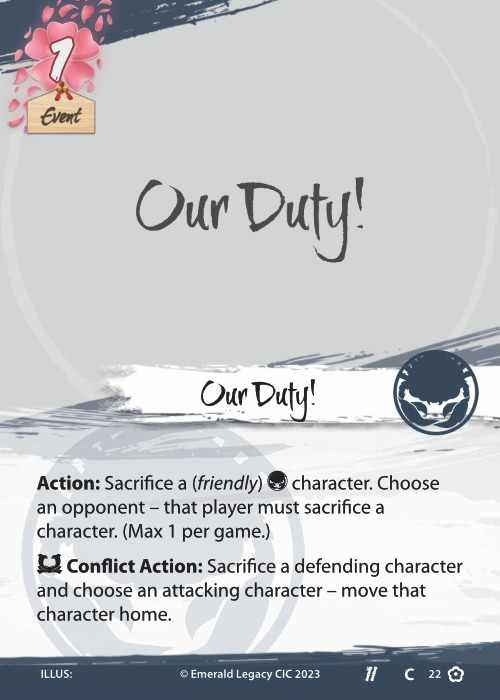The release of the new core set approaches! Together with the new core set, we are introducing a few rule changes. We’re keeping the essence of the game, but adding extra depth to some part of it, and streamlining other parts. Today, we will talk about an area where we are simplifying things: the dynasty phase.
The Dynasty, the Round, and the Game
In the Imperial format, a round in L5R is split in 4 phases with varying degrees of importance. Each phase builds on the previous, so let’s look at them in reverse order:
- The fate phase: a bureaucratic phase where we cleanup after the fight
- The conflict phase: the central part, it’s where the focus of the game is, where the players match their wits and fight for their victories. During the conflict phase the players use cards from their hands, and their characters to fight over provinces and honor.
- The draw phase: a simple phase where the players choose how many cards they want to draw for the round, the cards used in the conflict phase. The choices made here are clear and their connection with the conflict phase are direct
- The dynasty phase: another simple phase where the player chooses which character they want for the round and for how long they need those characters, the same characters that are used in the conflict phase. But the choices made here are less clear than we would expect, they carry subtleties that affect the whole game. The impact of those decisions is not a good match for how subtle the decisions are.
The oversized subtlety of the dynasty phase is what is commonly called “the passing fate”. The first player to pass during the dynasty phase gains 1 extra fate. Not only do they gain that fate, they also deny their opponents the opportunity to gain that fate. The standard fate per round is 7 fate per player, that extra fate represents 15% of extra resources. It is a big difference on its own, and when accumulated over multiple rounds it can come close to being a full extra round of resources for a player, if they get that advantage every round.
Unwrapping the Passing Fate
One of the changes to the dynasty phase with the new core set is the removal of the passing fate. Being the first player to pass during dynasty will not give any benefit. Let’s examine the effects of the passing fate in more detail, for they are many.
To increase the odds of getting passing fate, a player must buy fewer characters during dynasty. For this, players are better off building decks that buy a single character per round, putting a good amount of fate on those characters to maximize their value throughout the game. High cost characters are the best choices for that, while low cost characters become a bad choice. The evaluation of characters in regards to their cost becomes a curve, with their best spot being 3 cost. The low cost characters do not deliver enough impact on their own, you must buy multiple of them. But buying multiple of them leads to missing out on passing fate. Effectively, low cost characters operate as if they costed about half a fate more than what is printed in their cards. This overcomplicates character evaluation, and draws focus away from the conflict phase.
High cost characters then become preferable, as by being a single purchase they give their player one extra fate when they’re the first to pass. This makes the top of the cost curve easily reachable on the first round. With passing fate, players can buy a 5-cost character with 2 extra fate, and then gain 1 fate when they pass. The 2 fate on the character keeps them protected from being neutralized by a single Void Ring activation, the 1 extra fate from passing is often enough resources to manage the round efficiently: often that 1 Fate is put to use to ready that big character so they can work on two conflicts. Without passing fate, opening the game with a 5-cost character becomes extremely risky. If they are bought with 2 fate, their player will need to manage the whole round with no extra resources, which limits their options severely. If they are bought with only 1 fate, they’re at high risk of being neutralized by the Void Ring. Without passing fate, the distinction around 5-cost characters is larger, their tactical requirements are higher, and the timeline for putting those character into play is moved towards the late game. This let us design those cards with those distinctions in mind, creating cards that are built with a heavy assumption of being late game cards. This enables richer designs that would be hard to balance before.
High cost events and conflict characters are also affected. Cards like A Fate Worse Than Death or any high value conflict character are touched by this change. With passing fate, those cards are usually easier to afford, as they enable their players to pass early to capture the extra fate. They are effectively cheaper than their printed cost would indicate. Without passing fate, the investment for any of those cards is increased, making the space for design larger.
Streamlining the Action Opportunities
Another complexity of the dynasty phase is around which actions are permitted during the phase.
In the Imperial Format, players can play events from their hands, but not attachments or conflict characters. This led to a few interactions that were extremely potent by being able to hit players when they have a single character in play, like Way of the Crab.
In the previous version of the Imperial Format, the dynasty phase was changed to allow attachments and conflict characters to be played in an effort to reduce those interactions born out of single characters in play. Unfortunately, going in that direction leads to other issues, as it becomes easier for players to opportunistically wait until the opponent passes their last dynasty action, to then hit them with sequences of actions that the opponent is unable to respond, like setting up Noble Sacrifice. It also lets players wait for the opponent character purchases first, by merely playing attachments or other innocuous events and actions. That change went in the wrong direction, by adding extra complexity to solve a problem, instead of removing it.
With the new core set, players will not be allowed to play conflict characters or attachments, nor trigger any action abilities during the dynasty phase, unless the ability specifically allows that.
For example, the following abilities will not be allowed during the dynasty phase:
- Action abilities on characters, like Agasha Swordsmith or Alibi Artist
- Action abilities on holdings, like Underground Ophidiarium or Miya Library
- Action abilities on conflict events, like Way of the Crab or The Western Wind
Abilities that can only be triggered during the dynasty phase can still be triggered, like:
- Cards that are explicit about dynasty phase, like Kyuden Hida or Those Who Serve
- Dynasty events, like Ride at Dawn and Season of War
- Reactions or interrupts


What we expect from this
Based on aggregated data from Jigoku this year, the first player in the game has 20% higher odds of winning the match. With this change, we expect that advantage to be reduced.
By rebalancing the actual cost of characters into a more linear structure, with increased risk around 5-costers, we can create more design space for differentiating cards.
The rules simplification should make the game more welcoming towards beginners. Learning to master the passing fate was a hurdle for new players. We aim to keep the game at a very high level in terms of rewarding player skill, but the passing fate was a painful filter against beginners. Seeing the impact of it was hard, as the impact of it comes so late after the action. Passing early on round 1 would often only be felt at the end of the game, many rounds after. There is still plenty of skill expression around the dynasty phase, but the choices are easier to learn from.
In the new core set, we are adding complexity with versatile cards, and more interaction points than the original core set had. By simplifying the secondary, we can focus on the primary: the conflict phase.
That’s all for now. Make sure to check the site every day this week, and come back later for a special Halloween treat!




Hida Poi
What does a new core set mean for previous EL sets, and the FFG card pool?
Hida Amoro
For now, it means that the cards of the original core set and the complete Imperial cycle rotate out of the valid card pool. We will “reprint” some of the cards of the original core set, so don’t throw away all your cards. 😉 All other cards, FFG as well as EL, remain legal (if they are not on the ban list, of course).
We might come up with another format in the future, but that’s all for now.
Kakita Natsuo
What’s the anticipated economic impact of removing one of the only and most readily accessible source of fate acceleration? Not a criticism, the article has convinced me this is a good move, just curious.
Siri - Design Team
Design Team member here 🙂
This pushes fate acceleration into auxiliary cards, instead of it being so much a matter of character cost curve. With passing fate, you build your fate potential on top of running efficient characters and readies, to be able to manage the round with as few characters as possible. Without passing fate, it becomes more valuable to include card aimed directly at providing fate advantage.
It’s worth highlighting that fate advantage goes beyond simply gaining fate. It includes aspects of the game like denying fate from opponents (e.g. Cliffs of the Sea Dragon from Ancient Secrets), access to extending the life of characters on later rounds (e.g. Restorative Hot Spring from Restoration of Balance), direct character removal (e.g. Corner the Prey from Ancient Secrets) and other subtler effects. Many types of effects contribute to building fate advantage over the opponent.
In the new Core Set we worked with defined goals for how much access to each main resource of the game each clan should have. The 3 main resources were defined as: fate advantage, card advantage, and honor manipulation:
Crab:
Strong in Fate Advantage, Average in Honor Manipulation, Weak in Card Advantage
Crane:
Strong in Honor Manipulation, Average in Fate Advantage, Weak in Card Advantage
Dragon:
Strong in Fate Advantage, Average in Card Advantage, Weak in Honor Manipulation
Lion:
Strong in Card Advantage, Average in Honor Manipulation, Weak in Fate Advantage
Phoenix:
Average in all three resources
Scorpion:
Strong in Honor Manipulation, Average in Card Advantage, Weak in Fate Advantage
Unicorn:
Strong in Card Advantage, Average in Fate Advantage, Weak in Honor Manipulation
I hope this explanation clarifies the article and the thinking behind it. If you have more question, send them in 🙂
Graydius
With no passing Fate has it been considered to return to the second player receiving an additional Fate at the start if the game?
Hida Amoro
Hi there, no, it won’t come back. It would provide an even bigger advantage just for going second, without any other downside.